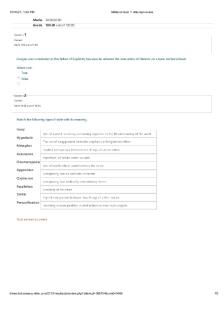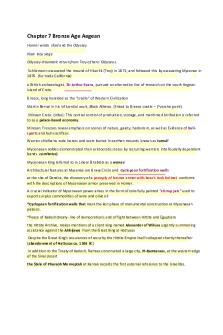Midterm 1 PDF

| Title | Midterm 1 |
|---|---|
| Author | Shihan Zang |
| Course | Economics of Sports |
| Institution | University of Connecticut |
| Pages | 3 |
| File Size | 70.8 KB |
| File Type | |
| Total Downloads | 80 |
| Total Views | 136 |
Summary
midterm 1...
Description
Name:____Answers______________ Econ 2447 Sports Economics First exam T. Miceli
Spring 2018
Multiple choice (4 points each). Write your answer in the space provided. _d_1. Sports economics is concerned with (a) The business of professional and big-time college sports (b) The determination of player salaries (c) The structure of the contest on the field (d) All of the above _c_2. Win maximization (a) Is never the goal of a professional sports team (b) Is always the goal of a professional sports team (c) Should result in a higher winning percentage compared to profit maximization, all else equal (d) Should result in the same payroll as profit maximization, all else equal _b_3. Marginal revenue is (a) Always equal to the price (b) Equal to the increment in revenue from selling one additional unit of output (c) Everywhere above the demand curve (d) An upward sloping curve _c_4. A monopolist maximizes profit by (a) Setting price equal to marginal cost (b) Setting marginal revenue equal to zero (c) Setting marginal revenue equal to marginal cost (d) None of the above _d_5. Sports leagues enhance the overall profitability of member teams by (a) Allowing them to cooperate in a joint venture (b) Allowing them to act as a cartel (c) Enacting rules that coordinate playoffs, scheduling, and promotion (d) All of the above _a_6. Revenue sharing within a league (a) Reduces the incentive of all teams to improve team quality (b) Is never practiced by sports leagues (c) Is designed to help the stronger teams (d) None of the above _d_7. Monopoly pricing by a sports team (a) Results in a price above marginal cost (b) Reduces consumer welfare compared to competitive pricing (c) Is possible because there do not exist perfect substitutes for individual teams (d) All of the above _b_8. Monopoly price discrimination for tickets to sporting events (a) Means charging higher prices for better quality seats in the stadium (b) Means charging different prices for the same seats to different types of consumers (c) Is impossible under monopoly (d) Is illegal
_d_9. Senior citizen discounts at sporting events (a) Is an example of third degree price discrimination (b) Occurs if senior citizens have more elastic demands than other consumers (c) Is only profitable if senior citizen tickers are not transferrable to other consumers (d) All of the above _a_10. Season ticket discounts (a) Are an example of second degree price discrimination (b) Are never offered by sports teams (c) Are offered by teams even though they result in lower profit (d) None of the above _b_11. Ticket scalping (a) Can occur if the price for an event is set too high, resulting in excess supply (b) Can occur if the price for an event is set too low, resulting in excess demand (c) Results in resale of tickets at prices below their face value (d) Is always legal _a_12. The optimal sporting contest (a) Maximizes aggregate revenue of teams subject to participation constraints (b) Is not based on economic principles (c) Imposes no limit on entry of participants (d) Should not specify the prize to be awarded to the winner _c_13. The level of effort on the field by a team in a sports league (a) Does not depend on the number of teams in the league (b) Does not depend on the prize for winning (c) Maximizes the team’s expected net return, taking as given the behavior of other teams (d) Is not understandable by economic analysis _c_14. The optimal sports league (a) Should have no governance structure (b) Should allow any city to enter a team in the league (c) Should balance cooperation in setting league policy with competition on the field (d) None of the above _d_15. Competitive balance (a) Is an objective of most sports leagues (b) Means that there is a roughly equal probability of winning for each team (c) Means the same thing as “parity” (d) All of the above _a_16. Competitive balance maximizes aggregate fan utility if (a) Fans are purely partisan and have diminishing marginal utility of wins for their team (b) Fans are purely partisan and have linear utility in wins for their team (c) Fans are irrational (d) None of the above True or False (3 points each). Write T or F in the space provided. 17. __T__ One reason sports leagues restrict free entry of teams is to prevent talent dilution. 18. __F_ Adding prize money for second place, third place, fourth place etc., while holding total prize money fixed, does not reduce competitive effort compared to a winner-take-all contest.
19. A team has 120 potential fans who may choose to attend one or more of the team’s five home games. 100 of the fans will pay up to $25 to attend a single game, but will pay nothing to attend any additional games. 20 fans, however, have the following demand schedule: Value of 1st game:$25 Value of 2nd game: Value of 3rd game: Value of 4th game: Value of 5th game:
20 15 10 5
Assume the team has a zero marginal cost per fan of supplying games. Write your answers to the following questions in the space provided. (a) What will the team’s total home attendance be if it sets a single game price of $25? What will its total revenue be? (10) Attendance = 120 (each fan will attend exactly one game) Revenue = 120×$25 = $3,000
(b) What is the maximum amount that a multi-game fan will pay for a season ticket allowing him or her to attend all 5 games? (10) Season ticket price = $25+20+15+10+5 = $75
(c) Suppose the team sets the price of individual game tickets at $25, but offers season tickets at the price you computed in (b). What is the team’s total home attendance, and what is its total revenue? How do your answers compare to part (a)? (10)
Attendance = 100 + 20×5 = 200 Revenue = 100×$25 + 20×$75 = $4,000...
Similar Free PDFs

Midterm 1
- 2 Pages

Midterm 1
- 3 Pages

Pexam 1 - practice midterm 1
- 1 Pages

CS122a F20Midterm 1 - Midterm 1
- 15 Pages

Psychology midterm 1 review
- 19 Pages

Midterm 1 notes
- 20 Pages

Midterm 1 Notes
- 4 Pages

Business 70 Midterm 1
- 19 Pages

Midterm 1, questions
- 10 Pages

FMPH 110 Midterm 1
- 7 Pages

Past Midterm #1
- 12 Pages

ENGL6100 - Midterm QUIZ 1
- 5 Pages

Notes for midterm 1
- 5 Pages

Midterm 1 cheat sheet
- 1 Pages

Summer Midterm 1
- 10 Pages
Popular Institutions
- Tinajero National High School - Annex
- Politeknik Caltex Riau
- Yokohama City University
- SGT University
- University of Al-Qadisiyah
- Divine Word College of Vigan
- Techniek College Rotterdam
- Universidade de Santiago
- Universiti Teknologi MARA Cawangan Johor Kampus Pasir Gudang
- Poltekkes Kemenkes Yogyakarta
- Baguio City National High School
- Colegio san marcos
- preparatoria uno
- Centro de Bachillerato Tecnológico Industrial y de Servicios No. 107
- Dalian Maritime University
- Quang Trung Secondary School
- Colegio Tecnológico en Informática
- Corporación Regional de Educación Superior
- Grupo CEDVA
- Dar Al Uloom University
- Centro de Estudios Preuniversitarios de la Universidad Nacional de Ingeniería
- 上智大学
- Aakash International School, Nuna Majara
- San Felipe Neri Catholic School
- Kang Chiao International School - New Taipei City
- Misamis Occidental National High School
- Institución Educativa Escuela Normal Juan Ladrilleros
- Kolehiyo ng Pantukan
- Batanes State College
- Instituto Continental
- Sekolah Menengah Kejuruan Kesehatan Kaltara (Tarakan)
- Colegio de La Inmaculada Concepcion - Cebu
